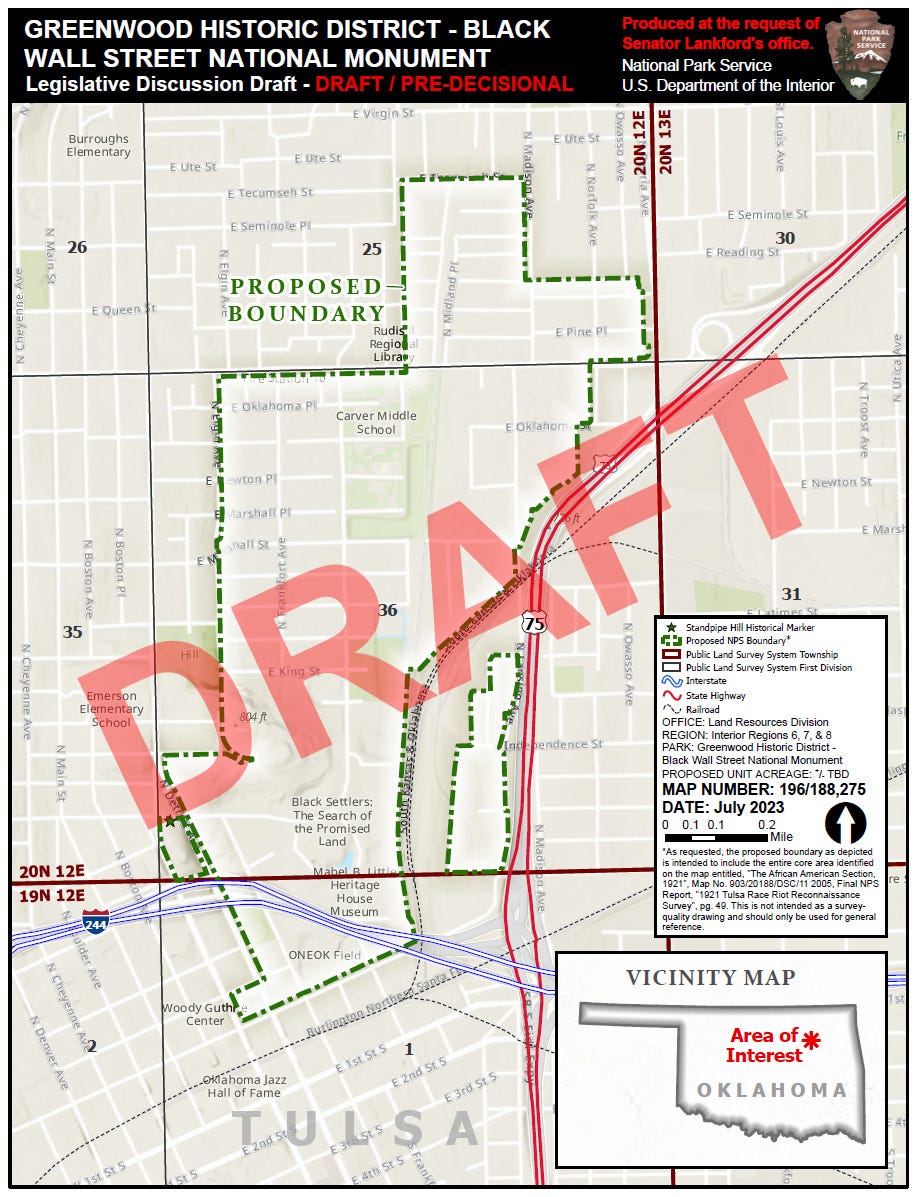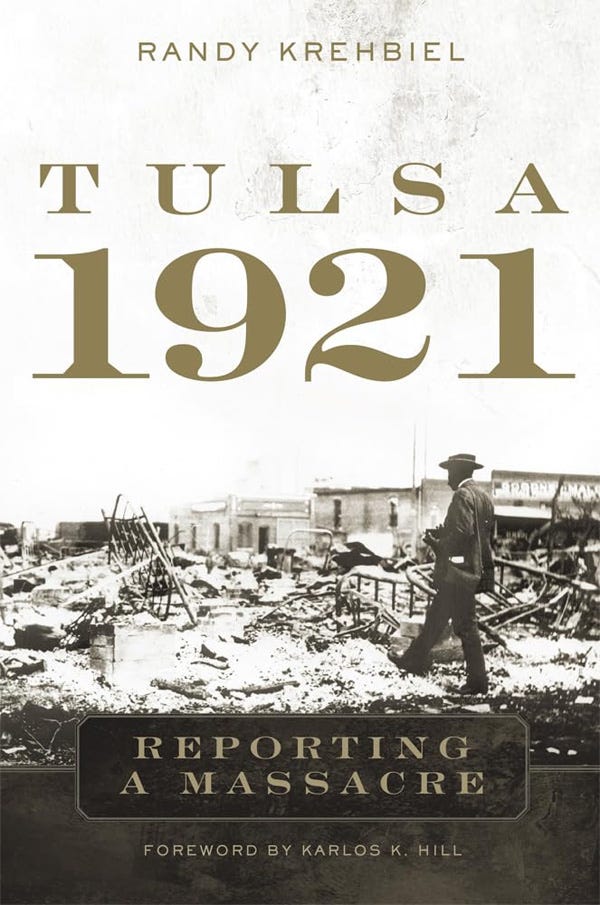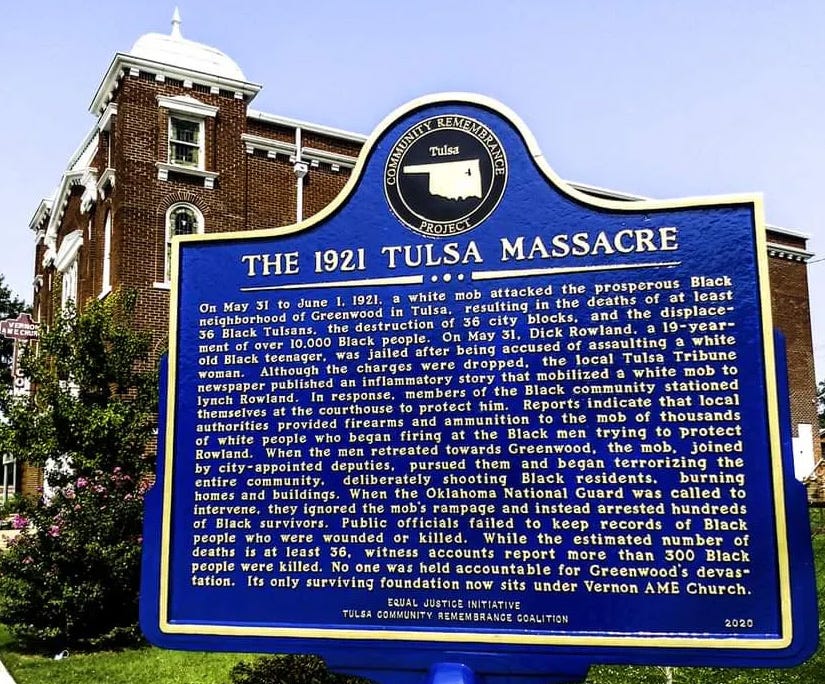Updated: Oklahoma Sen. James Lankford wants a huge part of downtown Tulsa to be moved to federal control thus directing ownership and future development. This will likely hike property taxes for everyone else in Tulsa County as this land goes off common property tax rolls – an area that stretches from Archer Street north beyond Pine Street, and from Elgin Street east to Peoria Avenue generally encompassing over 60 city blocks of downtown Tulsa to establish a memorial for a “massacre.”
Introduced in the U.S. Senate December 14, 2023, Sen. Lankford proposes the “Historic Greenwood District—Black Wall Street National Monument in the State of Oklahoma and for other purposes (S.3543).” If enacted, the area will be under the authority of the U.S. Secretary of the Interior.
S 3543, Section 3a: There is established the Historic Greenwood District—Black Wall Street National Monument in the State of Oklahoma as a unit of the National Park System to preserve, protect, and interpret for the benefit of present and future generations resources associated with the Historic Greenwood District, Black Wall Street, and the Tulsa Race Massacre of 1921 and the role of each in the history of the State of Oklahoma and the United States.
The bill legitimizes the title of “Tulsa Race Massacre of 1921” which this writer and others have long disputed. In short, two groups of armed civilians marched on the Tulsa County Courthouse in 1921. It was a civil insurrection or civil war if you prefer. Both groups brought guns from home and many WWI veterans engaged in the confrontation. Once fighting began, heart rending tragedy followed, but it was not a massacre. Oklahoma has suffered massacres before, from the Tonkawa Massacre to the Murrah Building bombing, but Tulsa, by objective analysis, was a civilian battle.
The Bill establishes a Commission to “advise the Secretary regarding the development and management of the National Monument including the construction of visitor service facilities and infrastructure” is also federally established. The Commission “shall be composed of 11 members of whom – 7 members shall be descendants, 3 members shall have experience in the field of historic preservation, and one member shall be appointed after consideration of recommendations submitted by the Mayor of Tulsa.” Members are appointed for 5-year terms and may be reappointed by the Secretary all serving without compensation, but “shall be allowed travel expenses, including per-Diem in lieu of subsistence” in the performance of duties of the Commission.”
The term “descendant” means, “an individual who can verify family lineage by blood, adoption, or marriage to a Black individual who lived in, worked in, or was present in the Greenwood District of Tulsa, Oklahoma, on May 31, 1921, or June 1, 1921, by— (A) family records, including family Bibles, vital records, correspondence, memoirs, journals, diaries, unrecorded deeds, diplomas, certificates, or testimonials; (B) public records, including censuses, government records, military records, pensions, land bounty records, passport applications, passenger lists, original grants, naturalization or immigration records, records of entry, or State, province, or local records; or (C) institutional records, including church records, cemetery records and inscriptions, educational institutions, insurance records, or societies and fraternal organizations.”
White and Indian residents of the area during the time are ignored in this Act.
Nothing in the Act “affects the land use rights of an owner of private property within or adjacent to the National Monument or requires any change in, or affects the construction of, interpretation of zoning laws applicable to, or appearance of any non-Federal property.”
“The Secretary, in consultation and coordination with Oklahoma State University [OSU], shall prepare a management plan for the National Monument,” the Bill states.
Oddly specific, a requirement within the Bill ensures that the administration does not interfere with the continuing use and ownership by OSU of Standpipe Hill which is the only ownership within the district specified. There are other public ownership such as ONEOK Field, school property, and Interstate Highway I-244.
The Bill states that the “Secretary may acquire any land or interest in land located within the boundary of the National Monument by donation, purchase from a willing seller or exchange.”
The writer most known for using the title of “massacre” is Randy Krehbiel, who currently covers state politics for The Tulsa World. He has written five books. The title in question is “Tulsa 1921: Reporting a Massacre” which he told this writer was not one he wanted for his work.
In a recorded interview, Krehbiel said it was local advocates that pushed the word massacre, over his objections, into the title published by Oklahoma University Press. Krehbiel said, “The original title was Politics, Race, and the Tulsa Riot of 1921. The [Commission] folks came in and said it was not a riot, it was a massacre in about 2018.”
In the spirit of full disclosure, Krehbiel and I are friendly associates. We have chatted at press conferences and public events for decades but have difficulty agreeing on much more than the time of day. Krehbiel sincerely believes in Critical Race Theory and denies that it is Marxist in any way. I disagree with both. However, we agree that officials in 1921 could have dealt with the tragic results of the insurrection at the time.
Krehbiel said, “Here is the thing that is the frustration with me: You don’t want to diminish what happened, but this was a national thing happening throughout the country and many people had events happen in their communities and they don’t even know it. The things that happened here reflected national tensions and attitudes, so Tulsa takes the hit for Elaine, Arkansas and Springfield, Illinois and Wilmington, NC and in Louisiana in the 1870s there was a big fight on the courthouse lawn and they don’t know how many died.
“One of the big things that got [Black Tulsans] going, I remind people from OKC, is the lynching of a black man in Oklahoma City in 1920,” Krehbiel said.
No lynching ever occurred in Tulsa.
“The [Tulsa] story has not been hidden, anyone who cared to look could find it,” Krehbiel said. As these quotes were recently confirmed, Krehbiel clarified, “Clearly, there were attempts to keep it quiet. When Ed Wheeler tried to write about it in the 1970s, no one would publish his story except Don Ross, and Wheeler was threatened. The riot/massacre was very rarely mentioned in newspapers, history books and the like. This was probably for several reasons. What I have said from pretty much the time I started working on this is that it was reported heavily at the time and those reports still exist for those who look.”
Contrary to Krehbiel’s assertion, this writer published Ed Wheeler’s story with both Wheeler and Ross’s permission online June 11, 1997 on TulsaToday.com. Other smaller local publishers have done the same. The Tulsa Today presentation may be found on the Internet Archive Wayback Machine here.
Update: Tulsa Today re-posted the original Ed Wheeler story March 8, (click here for that story) and a shorter version of this Lankford’s Massive Tulsa National Park story (click here for more) both referencing this Substack story post.
The following is the Editor’s Note introducing Ed Wheeler’s byline work in 1997:
A Tulsa Today reader asked for the true story behind Tulsa's most infamous and deadly race conflict. At work, he had received a version of the event June 1, 1921 written with great anger. That version said the World Book Encyclopedia contained no mention of the event under "riots, Oklahoma and Tulsa" and implied a conspiracy. However, we found it listed under "Race War" which is the most concise and accurate title for the day both white and black citizens grabbed their guns and ran to kill each other.
Several attempts have been made to tell the complete saga, but Tulsa Today sought out Ed Wheeler, the historical writer that first broke the story in 1971. Wheeler is an internationally recognized historical writer, general manager of corporate communications for one of Oklahoma's largest utilities and was the Task Force Commander Oklahoma National Guard during the Persian Gulf War. Brigadier General Ed Wheeler, ASU (Ret) took 2,000 Oklahoma soldiers to war and returned 2,000 home alive.
As Wheeler began his research in the early 70s, it quickly became obvious this was not a story some people wanted told. Strangers approached him to warn against publication. He moved his children out of his home. "I received direct threats," Wheeler said.
Wheeler interviewed ninety survivors, searched the records and was chilled to discover that official accounts of the conflict from the Oklahoma National Guard, Tulsa County Sheriff and the Tulsa Police Department had disappeared. "It took someone with a great deal of influence to accomplish that -- the lack of records is astounding. You could count more bodies in the pictures [that survivors retain] than the official body count," Wheeler said.
The story was originally commissioned by the editor of the Metropolitan Tulsa Chamber of Commerce's monthly magazine. However, when Executive Director Clyde Cole read the piece, he forbid publication. "He said it would cause a riot," Wheeler said. "The editors of the daily newspapers said they wouldn't touch the story with an eleven-foot pole."
Eventually the story was printed in the 1971 June-July issue of Impact Magazine. The larger local media organizations followed, but here is the story as it was first published.
Krehbiel said, “Someone once told me that no one word adequately describes what happened May 31-June 1 in Tulsa, and I tend to agree. If you were to ask me today whether what happened in Tulsa on May 31-June 1 was a riot, a massacre, a combination, or something else entirely I would probably say ‘all of the above and then some.’ It was all of those, depending on the exact place and time. But the argument over that description should not distract from the enormity of what happened. Whatever you call the riot/massacre, it destroyed a lot of lives.
Krehbiel said, “This discussion about massacre vs. riot is really about control of the narrative. This struggle for control of the narrative is always the case, no matter what the issue is. This is why we have thousands of books about the Civil War.”
Krehbiel added, “Today, if something looks like it might get violent, there are all kinds of police and national guard that show up and surround the place and tell people to go home or at least make it clear they are not getting into the building or whatever. When this was going on at the Courthouse at 6th and Boulder, you had the white sheriff and his black deputy trying to convince hundreds or even thousands of people to go home and they weren’t getting anywhere. They had the national guard less than a mile away, but for whatever reason they refused to call them until it was too late.”
What Tulsa began in the hope of reconciliation now appears to be focused on a self-interest narrative if not exaggeration and exploitation of tragic events.
One former member of that City Commission, on the condition of anonymity said, “I participated for a time until it became clear that reparations was the overwhelming objective of the group.”
If the reader has reviewed Ed Wheeler’s story, consider the difference between it and this historical marker by the Tulsa Community Remembrance Coalition or Project erected in 2020 in the photo below. The narrative presented as history is not accurate.
For more from promoters of the massacre narrative, click here for The Black Wall Street Times.
In coverage of Sen. Lankford’s National Park Bill, The Oklahoman December 18, 2023 wrote, “Although an official count reported only 36 people died in the massacre, unofficial estimates indicate hundreds of people were killed. Thousands were left homeless after roughly 35 blocks of the district were burned and destroyed.”
At last report, the total officially counted as victims stands at 37 after years of looking for additional victims suspected buried in multiple locations. That number is less than the average number of victims shot each weekend in modern Chicago. The claim that thousands were left homeless is also unproven but often asserted.
Given contrary unresolved narratives, it may be far too early to declare a national shrine despite how compelling such a move appears to pandering-politicians.
Taxpayers will suffer if such a large section of downtown Tulsa is removed from the property tax rolls. Property tax pays local obligations and when some don’t pay, everyone else must make up the difference. More on this topic in future editions of Straight Up on Substack.
Sen. Lankford said in his news release, “The Historic Greenwood District/Black Wall Street area in North Tulsa deserves its place among our nation’s significant historic locations. I have worked with my friends in North Tulsa to secure designations on the National Registry of Historic Places and on the Civil Rights Trail. Now, we are one step closer to establishing a national monument.”
Maybe it is time Tulsans pause, review, and consider carefully objective history, current community, and future growth. Any process may go astray over time, especially when directed by profit or politically motivated special interest agendas.
READER NOTICE: The purpose of Straight Up on Substack is to start a conservative conversation directly with readers at this critical crossroads for America. Not by command and control of our voices, but through a chorus of different voices freely communicating on policy. Hopefully, singing in the same key and, by Divine Providence, with harmonies.
Agree or disagree you may use the comment feature below for public response or email Arnett@substack.com for private communication.









I am coming to believe that Lankford is only a “conservative” in his election years.
I do not trust the Federal Government to have control of Downtown Tulsa land for any reason. They could do anything with that power! This land is ours, to have the freedom for commerce, worship, building, parks, memorials, festivals, shopping, restaurants, etc. WE the People, have the right, the freedom to make the decisions for the land, NOT THE FEDERAL GOVENMENT. Keep their hands off our land!